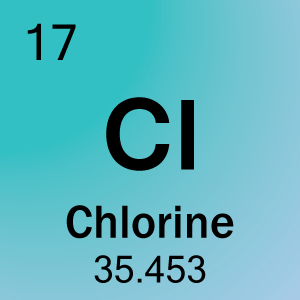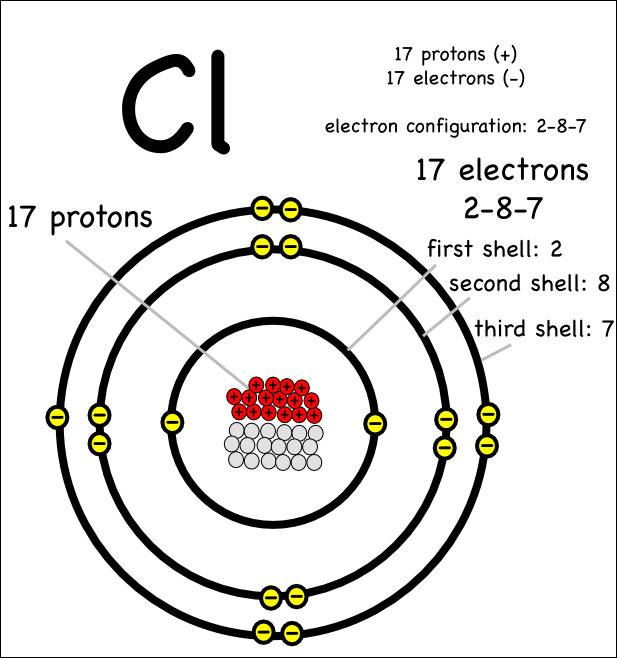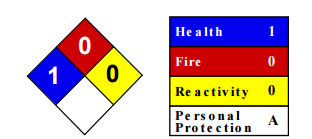Chlorine
Table of Content |
Discovery Year = 1774
Discovered by = Car Wilhelm Scheele
Origin of the Name = The name is derived from the Greek ‘chloros’, meaning greenish yellow.
Allotropes = Cl2
Introduction to Chlorine
Chlorine was initially manufactured by Scheele in 1774 by the activity of hydrochloric acid on manganese dioxide. In 1810, Davy built up its elementary nature and recommended the name chlorine by virtue of its colour.
The name "chlorine" is gotten from the Greek word "chlorous," which implies greenish yellow. Chlorine is a gas that is greenish-yellow in colour.
Fig. 1: Symbol, Atomic Number and Atomic Weight of Chlorine
Preparation Methods
-
Chlorine can be set up by heating manganese dioxide along with concentrated hydrochloric acid.
-
Chlorine is additionally prepared by the activity of hydrochloric acid on bleaching powder (or) lead dioxide potassium (or) permanganate.
Electrolytic Process
Chlorine is acquired by the electrolysis of salt water in a Nelson cell. This is the least expensive technique and gives the purest chlorine.
Fig. 2: Electrolytic Process of Manufacture of Chlorine
Deacon's process:
In this procedure, chlorine is manufactured by the oxidation of hydrochloric acid in the presence of cuprous chloride at 723K and a pressure of 1 atmosphere.
Physical Properties
-
It is a greenish-yellow gas with a pungent odor.
-
It has a boiling point of 239.11K and a melting point of 171.6K.
-
It is harmful in nature.
-
It is 2-5 times denser than air.
-
It can be effectively condensed.
-
It is marginally dissolvable in water.

Fig. 3: Physical Properties of Chlorine
Chemical Properties
Fig. 4: Electronic Configuration and Valency of Chlorine
-
Chlorine breaks up in water to give a firmly smelling, yellow arrangement called chlorine water.
-
Chlorine water loses its yellow shading on remaining in daylight, because of the arrangement of a blend of hydrochloric acid and hypochlorous acid. Hypochlorous acid, being unsteady, breaks down and releases nascent oxygen. The oxygen so shaped is in charge of the bleaching and oxidizing properties of chlorine.
-
It joins specifically with all non-metals aside from nitrogen, carbon, and oxygen.
-
Chlorine reacts promptly with most metals to frame their relating chlorides.
-
It has an extraordinary affinity for hydrogen. It joins with hydrogen in the presence of light with a blast to frame hydrochloric acid.
-
It breaks down a few hydrogen compounds to shape hydrochloric acid.
-
It is a decent oxidizing agent; it oxidizes ferrous to ferric, sulfur dioxide to sulphuric acid, sulfites to sulfates, and iodine to iodic acid.
-
Moist chlorine, because of the release of nascent oxygen, goes about as a very powerful bleaching agent. Moist chlorine fades organic matter or vegetables.
-
With slaked lime, it frames bleaching powder.
It reacts with unsaturated hydrocarbons to give addition products and substitution products with saturated hydrocarbons.
Example: While reacting with methane within the sight of daylight (or) ultraviolet light it gives chloromethane and ethene to 1, 2-dichloroethane.
Fig. 5: Reaction of Methane with Chlorine in the Presence of Light
Chlorine Poisoning: Chlorine is a chemical that counteracts bacterial development in stationary water. It's utilized to purify sewage and commercial waste. It's additionally an active ingredient in a few cleaning items.
Chlorine poisoning can happen when you swallow or breathe in chlorine. Chlorine reacts with water — incorporating the water in your digestive tract — to frame hydrochloric acid and hydrochlorous acid. Both of these substances are very harmful to people.
You might be most acquainted with chlorine that is utilized as a part of pools. Be that as it may, most occurrences of chlorine poisoning come about because of ingesting household cleaners, not pool water. A couple of regular household items and substances containing chlorine include:
-
Chlorine tablets utilized as a part of swimming pools
-
Swimming pool water
-
Mild household cleaners
-
Bleaching products
Material Safety Data Sheet for Chlorine
Fig. 6: HMIS of Chlorine
Uses of Chlorine
Chlorine is utilized as:
-
a bleaching specialist in the wood pulp, cotton and textile businesses.
-
to clean drinking water.
-
a antiseptic and disinfectant in swimming pools.
-
in the extraction of gold and platinum.
-
in the arrangement of harmful gasses, for example, phosgene, mustard gas and tear gas.
Watch this Video for more reference
More Readings
View courses by askIITians


Design classes One-on-One in your own way with Top IITians/Medical Professionals
Click Here Know More

Complete Self Study Package designed by Industry Leading Experts
Click Here Know More

Live 1-1 coding classes to unleash the Creator in your Child
Click Here Know More

a Complete All-in-One Study package Fully Loaded inside a Tablet!
Click Here Know MoreAsk a Doubt
Get your questions answered by the expert for free








